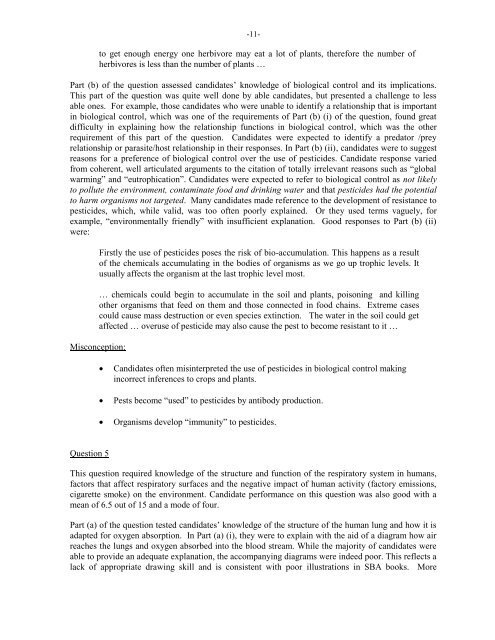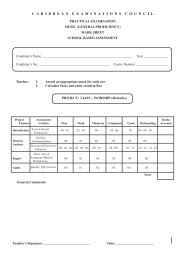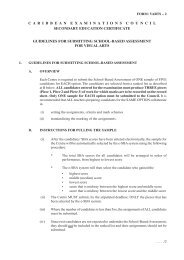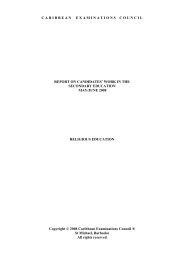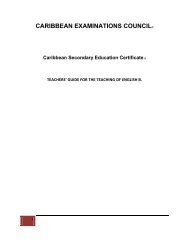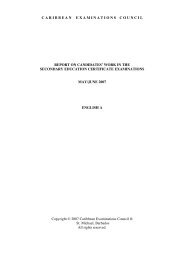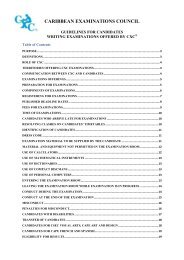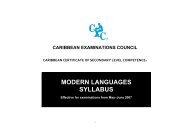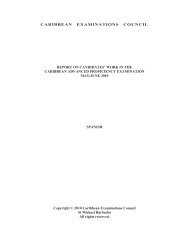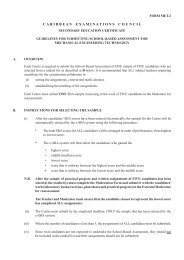Biology - Caribbean Examinations Council
Biology - Caribbean Examinations Council
Biology - Caribbean Examinations Council
You also want an ePaper? Increase the reach of your titles
YUMPU automatically turns print PDFs into web optimized ePapers that Google loves.
-11-to get enough energy one herbivore may eat a lot of plants, therefore the number ofherbivores is less than the number of plants …Part (b) of the question assessed candidates‟ knowledge of biological control and its implications.This part of the question was quite well done by able candidates, but presented a challenge to lessable ones. For example, those candidates who were unable to identify a relationship that is importantin biological control, which was one of the requirements of Part (b) (i) of the question, found greatdifficulty in explaining how the relationship functions in biological control, which was the otherrequirement of this part of the question. Candidates were expected to identify a predator /preyrelationship or parasite/host relationship in their responses. In Part (b) (ii), candidates were to suggestreasons for a preference of biological control over the use of pesticides. Candidate response variedfrom coherent, well articulated arguments to the citation of totally irrelevant reasons such as “globalwarming” and “eutrophication”. Candidates were expected to refer to biological control as not likelyto pollute the environment, contaminate food and drinking water and that pesticides had the potentialto harm organisms not targeted. Many candidates made reference to the development of resistance topesticides, which, while valid, was too often poorly explained. Or they used terms vaguely, forexample, “environmentally friendly” with insufficient explanation. Good responses to Part (b) (ii)were:Firstly the use of pesticides poses the risk of bio-accumulation. This happens as a resultof the chemicals accumulating in the bodies of organisms as we go up trophic levels. Itusually affects the organism at the last trophic level most.… chemicals could begin to accumulate in the soil and plants, poisoning and killingother organisms that feed on them and those connected in food chains. Extreme casescould cause mass destruction or even species extinction. The water in the soil could getaffected … overuse of pesticide may also cause the pest to become resistant to it …Misconception:Candidates often misinterpreted the use of pesticides in biological control makingincorrect inferences to crops and plants.Pests become “used” to pesticides by antibody production.Organisms develop “immunity” to pesticides.Question 5This question required knowledge of the structure and function of the respiratory system in humans,factors that affect respiratory surfaces and the negative impact of human activity (factory emissions,cigarette smoke) on the environment. Candidate performance on this question was also good with amean of 6.5 out of 15 and a mode of four.Part (a) of the question tested candidates‟ knowledge of the structure of the human lung and how it isadapted for oxygen absorption. In Part (a) (i), they were to explain with the aid of a diagram how airreaches the lungs and oxygen absorbed into the blood stream. While the majority of candidates wereable to provide an adequate explanation, the accompanying diagrams were indeed poor. This reflects alack of appropriate drawing skill and is consistent with poor illustrations in SBA books. More


